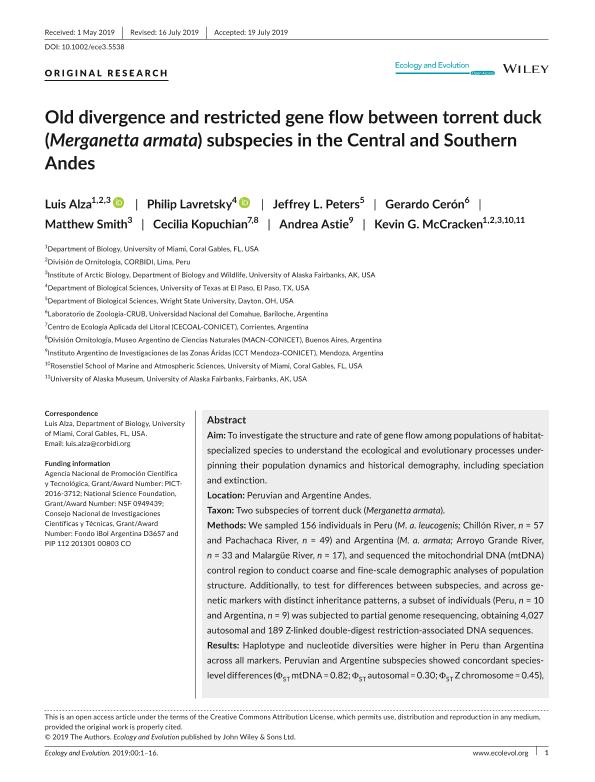Mostrar el registro sencillo del ítem
dc.contributor.author
Alza, Luis
dc.contributor.author
Lavretsky, Philip
dc.contributor.author
Peters, Jeffrey L.

dc.contributor.author
Cerón, Gerardo
dc.contributor.author
Smith, Matthew
dc.contributor.author
Kopuchian, Cecilia

dc.contributor.author
Astié, Andrea Alejandra

dc.contributor.author
McCracken, Kevin G.

dc.date.available
2020-07-13T19:22:45Z
dc.date.issued
2019-08
dc.identifier.citation
Alza, Luis; Lavretsky, Philip; Peters, Jeffrey L.; Cerón, Gerardo; Smith, Matthew; et al.; Old divergence and restricted gene flow between torrent duck ( Merganetta armata ) subspecies in the Central and Southern Andes; Wiley; Ecology and Evolution; 9; 17; 8-2019; 9961-9976
dc.identifier.uri
http://hdl.handle.net/11336/109180
dc.description.abstract
Aim: To investigate the structure and rate of gene flow among populations of habitat‐specialized species to understand the ecological and evolutionary processes underpinning their population dynamics and historical demography, including speciation and extinction.Location: Peruvian and Argentine Andes.Taxon: Two subspecies of torrent duck (Merganetta armata).Methods: We sampled 156 individuals in Peru (M. a. leucogenis; Chillón River, n = 57 and Pachachaca River, n = 49) and Argentina (M. a. armata; Arroyo Grande River, n = 33 and Malargüe River, n = 17), and sequenced the mitochondrial DNA (mtDNA) control region to conduct coarse and fine‐scale demographic analyses of population structure. Additionally, to test for differences between subspecies, and across genetic markers with distinct inheritance patterns, a subset of individuals (Peru, n = 10 and Argentina, n = 9) was subjected to partial genome resequencing, obtaining 4,027 autosomal and 189 Z‐linked double‐digest restriction‐associated DNA sequences.Results: Haplotype and nucleotide diversities were higher in Peru than Argentinaacross all markers. Peruvian and Argentine subspecies showed concordant species‐level differences (ΦST mtDNA= 0.82;ΦST autosomal = 0.30;ΦST Z chromosome = 0.45),including no shared mtDNA haplotypes. Demographic parameters estimated formtDNA using IM and IMa2 analyses, and for autosomal markers using ∂a∂i (isolation‐with‐migration model), supported an old divergence (mtDNA = 600,000 years before present (ybp), 95% HPD range = 1.2 Mya to 200,000 ybp; and autosomal ∂a∂i = 782,490 ybp), between the two subspecies, characteristic of deeply divergedlineages. The populations were well‐differentiated in Argentina but moderately differentiated in Peru, with low unidirectional gene flow in each country.Main conclusions: We suggest that the South American Arid Diagonal was preexisting and remains a current phylogeographic barrier between the ranges of the two torrent duck subspecies, and the adult territoriality and breeding site fidelity to the rivers define their population structure.
dc.format
application/pdf
dc.language.iso
eng
dc.publisher
Wiley
dc.rights
info:eu-repo/semantics/openAccess
dc.rights.uri
https://creativecommons.org/licenses/by-nc-sa/2.5/ar/
dc.subject
ANDES
dc.subject
GENES FLOW
dc.subject
GENETIC DIVERSITY
dc.subject
MERGANETTA ARMATA
dc.subject.classification
Zoología, Ornitología, Entomología, Etología

dc.subject.classification
Ciencias Biológicas

dc.subject.classification
CIENCIAS NATURALES Y EXACTAS

dc.title
Old divergence and restricted gene flow between torrent duck ( Merganetta armata ) subspecies in the Central and Southern Andes
dc.type
info:eu-repo/semantics/article
dc.type
info:ar-repo/semantics/artículo
dc.type
info:eu-repo/semantics/publishedVersion
dc.date.updated
2020-06-30T14:24:08Z
dc.identifier.eissn
2045-7758
dc.journal.volume
9
dc.journal.number
17
dc.journal.pagination
9961-9976
dc.journal.pais
Estados Unidos

dc.description.fil
Fil: Alza, Luis. University of Alaska; Estados Unidos. University of Miami. Department of Biology; Estados Unidos. División de Ornitología. Centro de Ornitología y Diversidad; Perú
dc.description.fil
Fil: Lavretsky, Philip. University of Texas at El Paso; Estados Unidos
dc.description.fil
Fil: Peters, Jeffrey L.. Wright State University; Estados Unidos
dc.description.fil
Fil: Cerón, Gerardo. Universidad Nacional del Comahue. Centro Regional Universitario Bariloche. Departamento de Zoología. Laboratorio de Parasitología; Argentina
dc.description.fil
Fil: Smith, Matthew. University of Alaska; Estados Unidos
dc.description.fil
Fil: Kopuchian, Cecilia. Consejo Nacional de Investigaciones Científicas y Técnicas. Centro Científico Tecnológico Conicet - Nordeste. Centro de Ecología Aplicada del Litoral. Universidad Nacional del Nordeste. Centro de Ecología Aplicada del Litoral; Argentina. Museo Argentino de Ciencias Naturales, División Ornitología,; Argentina
dc.description.fil
Fil: Astié, Andrea Alejandra. Consejo Nacional de Investigaciones Científicas y Técnicas. Centro Científico Tecnológico Conicet - Mendoza. Instituto Argentino de Investigaciones de las Zonas Áridas. Provincia de Mendoza. Instituto Argentino de Investigaciones de las Zonas Áridas. Universidad Nacional de Cuyo. Instituto Argentino de Investigaciones de las Zonas Áridas; Argentina
dc.description.fil
Fil: McCracken, Kevin G.. División de Ornitología. Centro de Ornitología y Diversidad; Perú. University of Miami. Department of Biology; Estados Unidos. University of Miami; Estados Unidos. University of Alaska; Estados Unidos
dc.journal.title
Ecology and Evolution
dc.relation.alternativeid
info:eu-repo/semantics/altIdentifier/doi/http://dx.doi.org/10.1002/ece3.5538
dc.relation.alternativeid
info:eu-repo/semantics/altIdentifier/url/https://onlinelibrary.wiley.com/doi/full/10.1002/ece3.5538
Archivos asociados
